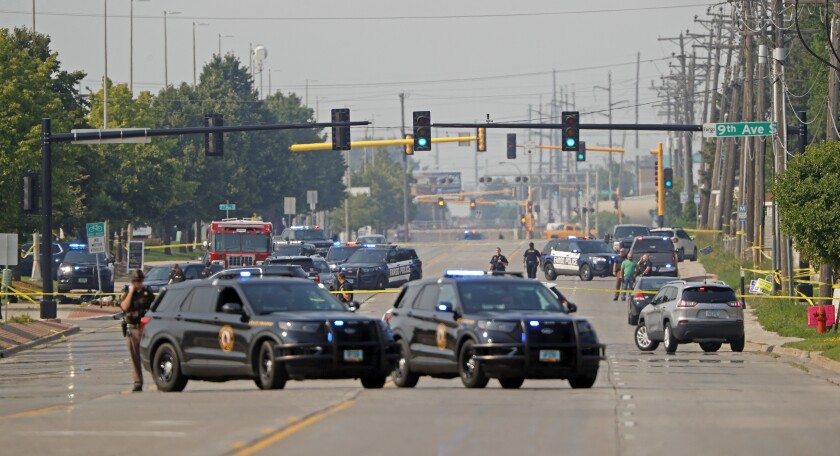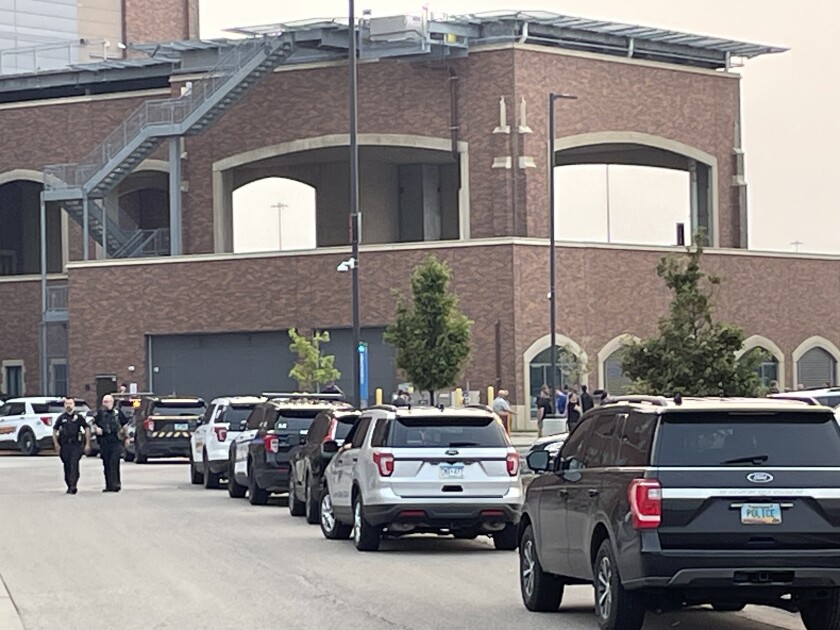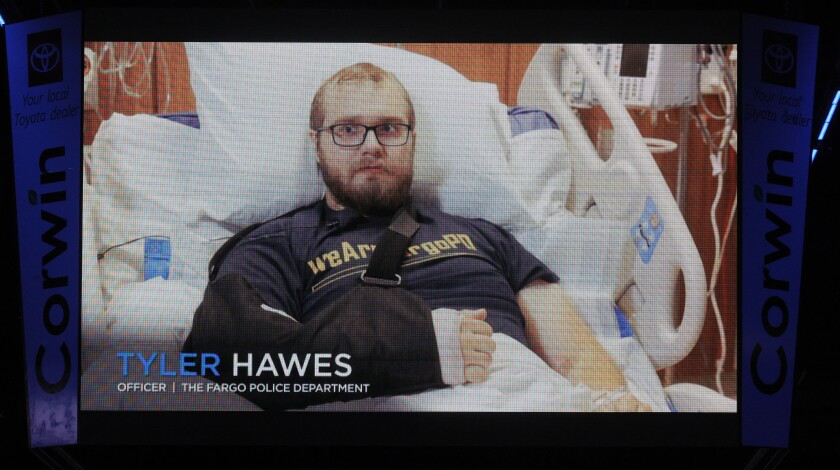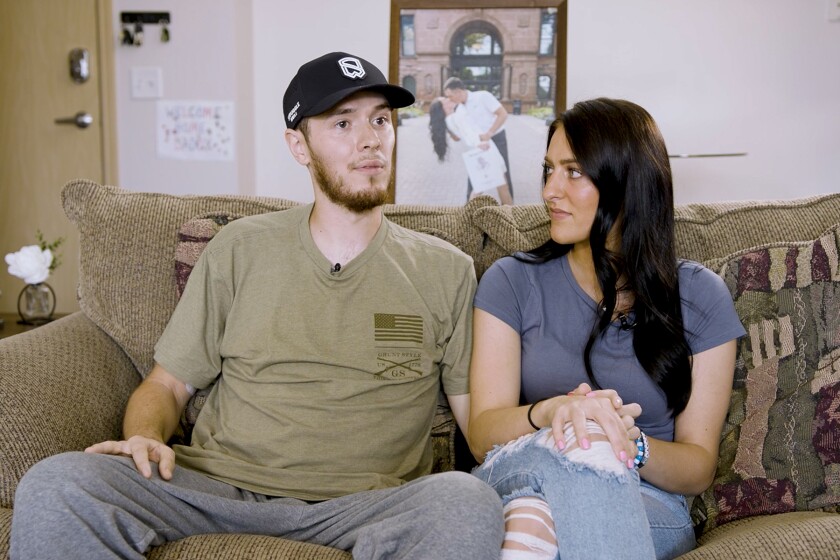FARGO — It had been a quiet Friday afternoon. Ryan Hiatt was taking a bag of trash outside to the disposal bin at the headquarters of Sanford Ambulance when he heard “a bunch of sirens.”
Moments later, his cellphone rang: Central dispatch notified him that a police shooting was in progress, with multiple victims.
ADVERTISEMENT
“It caught me off guard,” said Hiatt, Sanford Ambulance’s emergency medical services operations supervisor. “I knew this was going to be a big incident.”
It was the afternoon of July 14, 2023 — the day All of the surviving victims were treated at Sanford Medical Center, posing a major test of the top-level trauma center.
Hiatt ran into headquarters, looking for members of his leadership team. All had taken off for the day. “Call everybody,” Hiatt told his office manager. “Get as many people as you can.”
He and two other responders jumped into an ambulance and immediately drove north, initially informed the shooting was happening at the intersection of 25th Street and 12th Avenue North.
Once past the Interstate 94 overpass, however, Hiatt could see the shooting spree was unfolding much closer, with emergency lights flashing and “dozens of vehicles” converged at the intersection of 25th Street and Ninth Avenue South.
“We knew we needed to be there ASAP,” he said, although he still didn’t have the OK to approach the scene. Moments later, a dispatcher told Hiatt the shooter had been “neutralized,” so it was safe to go to the scene.
Hiatt had never seen anything like it. “There was such a tense feeling in the air,” he said. He didn’t know how many shooting victims he would find — or whether any would be police officers or firefighters he knew from work.
ADVERTISEMENT
“The officers were shouting at us to get over here,” Hiatt said. “This person needs help, this person needs help.”
He saw a wounded police officer lying on the ground, surrounded by fellow officers.
As Hiatt jumped out of his ambulance, he started to formulate a plan. At first, he intended to assume a command role, but quickly got “sucked in” to treating the wounded.
Once three or four ambulances were on hand, he was able to survey the scene. He saw a jumble of police officers and firefighters giving aid as the paramedics worked on the wounded, preparing them for transport to the hospital.
“It was a very surreal incident,” Hiatt said. “There was equipment everywhere. There was blood all over the sidewalk.”

Scanning the scene, he saw a police officer and a firefighter performing CPR on someone — then realized it was who would succumb to fatal wounds.
On the berm, Hiatt saw emergency responders caring for a woman, who was involved in the fender-bender and was wounded in the shooting spree. They also were tending to who ultimately died from a gunshot wound.
ADVERTISEMENT

Paramedics had done all they could for the shooting victims; it was time to rush them to the hospital. Moments after the shooter was hit, the first ambulance departed, with others leaving soon after.
The gravity of the shootings began to sink in once the scene was cleared. “All the patients were gone,” Hiatt said. Then, he had a quiet moment to ponder: “What the hell just happened?”
'A sea of blue'
Once alerted that there had been a mass shooting with multiple victims, emergency department teams at Sanford Medical Center scrambled to get ready.
Mass shooting. Multiple victims.

“In drills, we’ve heard those terms, but never in real life,” said Melony Anderson, an emergency room nurse who was called in to help. “It seemed like organized chaos. It was running like a well-oiled machine.
A call was made for more blood units, and doctors and nurses rushed to finish with patients to make room for the shooting victims. “The department was pretty full,” said Nathan Parrett, an emergency room clinical care leader. “We had to shuffle patients around, we had to discharge patients, we had to get patients into the hospital.”
Teams of doctors, nurses and others were assigned to rooms as they waited.
ADVERTISEMENT
Anna Ferguson, a registered nurse who was on rapid response duty that day, a floating role, turned up at the emergency department to help.
“At first, it was just a sea of blue,” she said, referring to the nurses and doctors standing by in their scrubs. “I’ve never seen anything like it.”
Then, the first ambulance arrived.
“There’s certainly an intensity in the room, but this is what we train for,” said Sherrie Syverson, Sanford Health emergency room clinical care leader. “Many of us, this is why we go into emergency medicine.”
Fortunately, lots of seasoned members of the emergency department were on hand, said Dr. Paul Bilstad, an ER physician.
“This truly is a team approach, not an individual approach,” he said, with doctors and nurses joined by respiratory therapists, nurse anesthetists, phlebotomists, aides and technicians. “We had all the people at the table that we needed.”
Within about 30 minutes, the emergency department had stabilized the patients in preparation for surgery.
ADVERTISEMENT
Bilstad turned his attention to other patients who were waiting to be seen in the emergency department, many of whom were following news of the shootings on their phones.
“They were very understanding,” he said. “They said, ‘Take all the time you need.’ I think they realize that the sickest patients have to go to the front of the line. That doesn’t always happen in the emergency department. That day was very different.”
Sorting through chaos
Dr. Enej Gasevic’s hopes that his shift would wrap up early on what had been an uncharacteristically quiet day ended when he was summoned for surgery.
There had been a mass shooting, he was told, and his skills were needed. A trauma surgeon, Gasevic trained at an inner-city medical center in Detroit, where he operated on many gunshot victims.
“That was probably 80% of what we did,” he said. His record was treating 18 gunshot wounds in a shift.
As it happened, Gasevic was not far from the scene of the shootings when the call came in, and he wound up following one of the ambulances to Sanford Medical Center. He was assigned that day to acute surgery, but he was needed in trauma surgery.
Gasevic was assigned to operate on Andrew Dotas, the most critically wounded of the surviving police officers.
ADVERTISEMENT
After a quick examination, Gasevic knew he would have to treat at least one gunshot wound that had pierced the abdomen and chest — clearly a life-threatening wound.
“There was definitely life-threatening bleeding” requiring “quite a few transfusions,” he said.
“Things went extremely well that day,” he said. “I got really good help, and they made me look good. A lot of it comes down to teamwork.”
At one point, there were between 15 and 20 people in the operating room, each performing a specific role. “It’s really organized chaos,” Gasevic said. “It’s a lot of things happening all at once.”
Later, Gasevic reviewed video of the shootings and saw that Dotas was shot at close range.
“It was essentially across the room,” he said. “At those distances, rifle shots tend to be absolutely devastating.” The surgeon’s job, he said, becomes “damage control surgery” to stop bleeding and eliminate contamination.
Both Dotas and Tyler Hawes, the other surviving Fargo police officer wounded in the shooting, required multiple operations to repair the damage.

“I think I ended up operating on both of them two or three times in the next 72 hours,” Gasevic said. “It’s a process and a project.”
By the weekend, both Dotas and Hawes were breathing without assistance and were beginning their recovery.
“They had some setbacks as you’d expect with this sort of thing,” Gasevic said. “They were young, fit, motivated individuals.”
Over the next two or three weeks, Gasevic became acquainted with Dotas and his wife.

“They’re amazing people,” he said. “I’m honored and privileged to have been able to play a small part in taking care of him.” Gasevic was inspired by Dotas’ dedication and lack of anger. “He took in stride everything that happened,” he said. “He was just somebody doing his job, and someone shot him with a rifle at short range. It’s his job to be there for other people.”
'It can happen anywhere'
Emergency room staff, who trained for years to handle a mass casualty event, had confronted the reality of one.
“It took me a few days to sort out how I felt,” said Parret, who went home to a family birthday celebration after his shift ended on July 14. Now that Fargo has seen a mass shooting, it’s no longer left to the imagination.

“It’s closer to the front of my mind,” he said.
Those who played a part in the medical response to the shootings were proud of what they accomplished but were left with the unsettling knowledge that Fargo isn’t immune to such tragedies.
“You realize if this can happen in Fargo," Syverson said, "it can happen anywhere."









